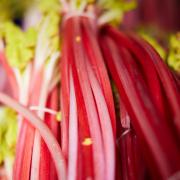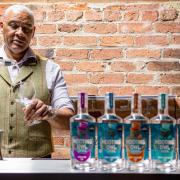The Yorkshire coast has pots and pots of lobsters – so why aren’t more of us tucking in?

When it comes to lobster, it just doesn’t seem right to eat one that’s older than the Duke of Edinburgh.
Yes, it will probably have the same chew factor as a mouthful of rubber bands, but that’s not the only reason to pass.
‘They can live for decades,’ said Bob Roberts, owner of The Yorkshire Lobster Company in Scarborough. ‘This fella (holding up a particularly impressive specimen) is about 1.5 kilos and must have been around for years. At a guess, I’d say he’s at least 100. It just wouldn’t seem right to eat him now. He’d be pretty rubbery, but it’s more that he’s paid his dues and should be allowed to live out his life in peace. I’ll just notch his tail (a conservation practice that protects a number of lobsters to maintain stocks) and put him back.’
The average lobster landed off Yorkshire’s coast is small and sweet (in terms of flavour if not temperament), weighing in at around 400-500g, with an attractive navy-black speckled carapace and a vivid blue tail fan and legs.

Bob’s crew – skipper Kevin Trotter (‘one of the best in the business’) and Jimmy Whitlow (‘a real grafter’) – take out his boat, Capernaum, every day at 4am if the weather allows, returning in the early afternoon with around 50kg (100 or so lobsters), which are then sold for somewhere in the region of £11 per kilo (depending on the season).
They don’t have to venture far out to sea as lobsters thrive on the edge of the rock about five miles from the coast, stretching from the cliffs at Flamborough right up to the Tees estuary. They share their outcrop with crabs (just imagine the ferocity of their neighbourhood disputes), who also get scooped up by Kevin and Jimmy and brought ashore to be sold on.
Interestingly (if a little stomach-churningly), while crabs enjoy fresh bait, like mackerel backs, lobsters can only be tempted by rotten bait, like salmon heads. And, at the height of the season – from the end of June to early September – these rancid delicacies can attract upwards of 80-90kg of them into the pots.
‘The stocks around Scarborough and up the coast to Ravenscar are plentiful because lobster love the cold water,’ said Bob. ‘Ours tend to be blue-black ones, but they come in all sorts of colours. Some people talk about the Filey Blue like it’s a unique species, but it’s just a brighter colour. You get orange ones and speckled ones and all sorts. They’re like us – some of us have blonde hair, some are dark, some have blue eyes, some have brown, but we’re all human, aren’t we?’

There are about 30 lobster boats in Scarborough bringing in huge numbers of the clawed beasties every day – a staggering 95 per cent of which is shipped out of the country.
‘It’s the same with all our shellfish,’ said Bob. ‘Ninety five per cent goes overseas. We even export whelks and live crabs from Scarborough to China.
‘As a country, we just don’t eat enough of it ourselves, which means we’re missing out. The lobster you treat yourself to on your holiday in Spain or France or wherever was probably caught here in Scarborough. How daft is that?
‘Given a choice, I’d much rather supply restaurants and retailers within a short van drive of the coast – from lobster pot to plate within Yorkshire – but it’s easier said than done. I think it’d be great if we could put a tag on lobster tails so everyone could see where they’re from, but I think some people like to say they’re serving fresh local lobster when it’s not that fresh or local, so they might not entirely welcome a ‘Caught in Yorkshire’ label.’

Bob comes from a Scarborough fishing family, but his father tried to steer him and his brother away from the sea.
‘He didn’t want us following him into the business because he knew how hard it was and, to be honest, I didn’t fancy it much either,’ he said. ‘So, I trained as a boat-builder and did 20 years in the Navy. When I came out, my brother was fishing and I said I’d give him a hand. Then it got to the point when I fancied a boat for myself, just to putter about in. I went after a few lobsters, bringing in a box or two. Then it just grew and grew. It started as a hobby because I find lobsters absolutely fascinating; we know so little about them, so there’s always things to discover.’
With the launch of The Yorkshire Lobster Company, his hobby is now very much a business – and a thriving one at that. Like the other lobster potters around Scarborough, he can sell everything he lands.
Bob uses a Canadian water filtration system, which uses carbon and coral filters to transform ammonia into soluble nitrates, keeping the live lobsters fresh, cool and docile for up to a month on-shore.
‘If you let the temperature rise, they don’t behave themselves,’ said Bob. ‘They’re a cannibalistic bunch given half a chance. If you leave them in a box together without banding them and lowering the temperature, you’ll just come back to a box of claws. They’ll eat every bit of each other apart from the claws.’
And, while we’re making you feel a little squeamish, let’s talk about the knotty problem of how to transform a live lobster into a delicious entrée. (Look away now if you’re not keen on claw-related gore.)
‘People are naturally uncomfortable about the killing process,’ said Bob. ‘Some boil them alive, but I understand they’re conscious for about 15 seconds and that seems too long to me. I don’t want to be cruel. Some people go in with a knife at the back of the head or skewer them through the eye. Some simply twist and pull them in half.
‘I’ve invented my own killing machine though. It’s a bit Heath Robinson, but it does the job quickly and quietly. The lobsters we catch here in Yorkshire have had a good life and I want to give them a good death too.’
So, he simply puts a couple of boxes of lobsters into his home-designed water tank and runs a one amp electric charge through it. It takes less than a second.
Bob is obviously passionate about his catch – he lights up when talking about lobsters and positively beams when he picks up one of the cranky little devils – but he’s realistic about the future of his business.
His daughters Zoe and Zara are busy with their own careers, in the Royal Navy and as part of a superyacht crew, so when he retires, the Capernaum will probably retire with him. It’s difficult to imagine him giving up altogether though. And, anyway, there could be even more interesting things to catch off the Yorkshire coast by then.
‘Global warming could well have an effect on the local stocks,’ said Bob. ‘If the water starts to warm up, the lobsters will migrate north. But then we’ll get bass and octopus migrating here to replace them.’



























